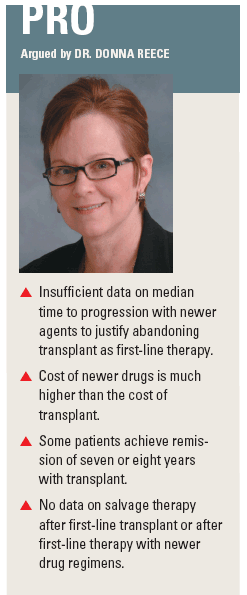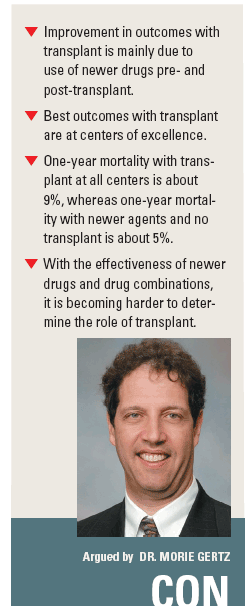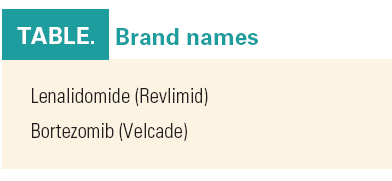Should high-dose chemo/transplant still be considered first-line therapy in myeloma?
With the availability of newer drugs for treating multiple myeloma, such as proteosome inhibitors and immunomodulatory drugs (IMiDs), outcomes and depth of response are steadily improving. These developments have led to a debate about whether high-dose chemotherapy and autologous stem cell transplant should still be considered first-line therapy or whether newer drug regimens should replace transplant.
ABSTRACT: Advanced autologous stem cell transplant techniques and high-dose chemotherapy vie to meet the goal of prolonged disease control.
With the availability of newer drugs for treating multiple myeloma, such as proteosome inhibitors and immunomodulatory drugs (IMiDs), outcomes and depth of response are steadily improving. These developments have led to a debate about whether high-dose chemotherapy and autologous stem cell transplant should still be considered first-line therapy or whether newer drug regimens should replace transplant.
Oncology News International spoke with two myeloma experts: Donna Reece, MD, argued that transplant should not be abandoned as first-line therapy, while Morie Gertz, MD, posited that a drug regimen offers the advantage of long-term disease suppression.
Transplant: Not a barbaric procedure
“I don’t believe we have sufficient data yet to support abandoning transplant,” said Dr. Reece, who is director of the Program for Multiple Myeloma and Related Disorders at Princess Margaret Hospital in Toronto. “The new drugs are clearly more exciting than the older drugs in our armamentarium, but we do not yet have complete data on median time to progression and survival with these newer agents. Perhaps in the future, we will have enough information to justify this paradigm shift, but that is not the case at present.”

The goal of management for multiple myeloma is the achievement of prolonged periods of disease control with a good quality of life by the judicious use of sequential treatment regimens, she said. “The goal has realistically never been cure in most centers,” she added.
Outcomes are improving with both new transplant techniques and newer drug-only regimens. With older transplant techniques, median progression-free survival (PFS) is 2.5 to three years, and appears to be longer in more recent studies, she said. “We don’t know the progression-free survival with newer drug-only combinations, such as Revlimid/dexamethasone (RD) or Revlimid/bortezomib/dexamethasone (RVD),” she emphasized (see Table).
The ECOG E4A01 trial compared lenalidomide plus high-dose dexamethasone with lenalidomide plus low-dose weekly dexamethasone. The high-dose arm was much more toxic than the low-dose arm, and median time to progression for both groups was about two years (ASCO 2008 abstract 8504).
“Some of these patients went on to transplant, so this trial does not tell us about the true time to progression with Revlimid/dexamethasone. To make a decision to abandon transplant as part of initial therapy, I would need those data,” she emphasized.
A separate retrospective analysis of 100 patients treated with lenalidomide/dexamethasone at the Mayo Clinic in Rochester, Minn., reported a median time to progression of 31 months (Blood online, March 26, 2009).
Median time-to-progression is similar for older transplant studies and for studies of newer drug-only regimens: 2.5 to three years for transplant and 31 months with lenalidomide/dexamethasone. However, cost is an issue. One autologous stem cell transplant is about half the cost of one year of Revlimid therapy: transplant costs about $44,000, while the cost of one year of treatment with Revlimid is about $112,000 in Canada, Dr. Reece said.
“Some people say that taking pills is easy while transplant is associated with a great deal of morbidity. Transplant is not that bad. Patients have a definite period of fatigue, but it is hardly a barbaric procedure. Mortality in our center is approximately 1.5%, and some patients clearly achieve remissions which last for seven or eight years,” she said.
Since achieving remission is almost universal with modern treatment, the availability of effective salvage therapies is another important consideration in selecting first-line therapy. While there are ample data on the use of lenalidomide/dexamethasone as salvage therapy after transplant, there are no data on salvage strategies after first-line stem cell transplant or after first-line lenalidomide/dexamethasone or other newer combination therapies such as RVD.
“Since achievement of a relatively durable remission-with or without maintenance therapy-is one of the main reasons to undergo a transplant, it is also not clear whether delayed stem cell transplant will buy a meaningful remission duration that is as long as is achieved with stem cell therapy as first-line treatment,” she said. “I do not feel comfortable recommending a strategy of first-line drug therapy alone, until I have all this information.”

It is hoped that a study being planned at Boston’s Dana-Farber Cancer Institute and the Intergroup Francophone du Myelome will shed some light on this issue, but results won’t be available for at least five years. That study will enroll 1,000 patients, treat them with RVD, collect stem cells, and randomize them to transplant or several more cycles of RVD. Then all patients will get lenalidomide as maintenance therapy. Transplant will be performed at the time of relapse in the RVD arm.
“We need to have data showing that upfront RVD or RD with transplant as salvage therapy is as good as upfront transplant followed by RVD or RD,” Dr. Reece said. In addition, multiple myeloma is a heterogeneous disease, and treatments are not one size fits all. “We are learning which patients will derive preferential treatment from one strategy versus another, but we don’t have all the answers yet,” Dr. Reece said.
“The situation in myeloma is confusing to community doctors. They are being told that drug therapy is kinder and gentler than transplant, but we don’t have the evidence yet to make sweeping statements about abandoning transplant as first-line therapy. Also, if patients have RVD upfront, for example, we don’t know what to give them at relapse,” she stated.
Minimal residual disease
According to Dr. Gertz, transplant should be first-line treatment if one believes that multiple myeloma is a disease like acute leukemia: curable with induction therapy, transplant, and consolidation maintenance therapy without regard to quality of life and adverse events.
“The position one assumes in this debate depends on one’s philosophy regarding goals of treatment,” explained Dr. Gertz, chairman of medicine at the Mayo Clinic in Rochester, Minn.
“But if you believe that multiple myeloma behaves more like a chronic incurable illness such as AIDS, then the goal of treatment would be effective therapy that achieves long-term suppression-and no cure-with good quality of life,” he said. “I believe that multiple myeloma is not a curable disease. Minimal residual disease should be the goal of treatment, not eradication of disease.”
One of the justifications for transplant has been that it achieves a high complete response (CR) rate. However, CR may indicate a bias toward patients with biologically favorable chemosensitive disease. “CR may be more of a prognostic factor than a result of therapy,” Dr. Gertz said. He added that patients who do not achieve a CR on their planned course of therapy should not receive any additional therapy. “Some experts might argue that these patients should receive more intensive therapy to deepen the response to CR,” he said. “CR should not be the endpoint or goal of therapy. Very good partial response or better should be the endpoint.”
Using ever more intensive combination therapies to boost response rates and PFS may be misguided. “Response rates and PFS are not ideal endpoints for myeloma clinical trials either. Even though adding more drugs to combination therapy achieves higher response rates, when those patients progress, they have fewer salvage options because you have used up all your options,” he said.
He said that overall survival would be a better endpoint than PFS. “PFS doesn’t tell us about the optimal number of drugs for induction therapy. Using overall survival as an endpoint in clinical trials would answer the question of the best way to treat multiple myeloma,” he said.
Randomized trials conducted in the 1990s showed a 12-month difference in survival for transplant vs standard therapy at the time. Registry data showed a slight improvement in survival for transplant in the 1980s and 1990s (Blood 111:2516-2520, 2008). “Now our standard therapy is transformed dramatically and it becomes difficult to know what survival benefit transplant provides versus current standard therapy,” he said. “But the real improvement in survival came in 2000 with the introduction of IMID therapy.”

Several studies that show no survival difference between early and delayed transplant also raise questions about the use of transplant as first-line therapy (Blood 92:3131-3136, 1998; J Clin Oncol 24:929-936, 2006; Haematologica 92:928-935, 2007). Transplant carries a treatment-related mortality, depending on the center where it is performed. “The more experienced the center, the better the mortality results,” Dr. Gertz said. Registry data from nationwide centers show a one-year mortality of about 9%, “which is unacceptably high,” he said (Bone Marrow Transplantation 32:1135-1143, 2003). With novel agents and no transplant, one-year mortality is at 5% and two-year survival is about 88%.
“With improved drug regimens, it is getting increasingly harder to decide the ultimate role of high-dose chemotherapy and autologous stem cell transplant,” Dr. Gertz stated.